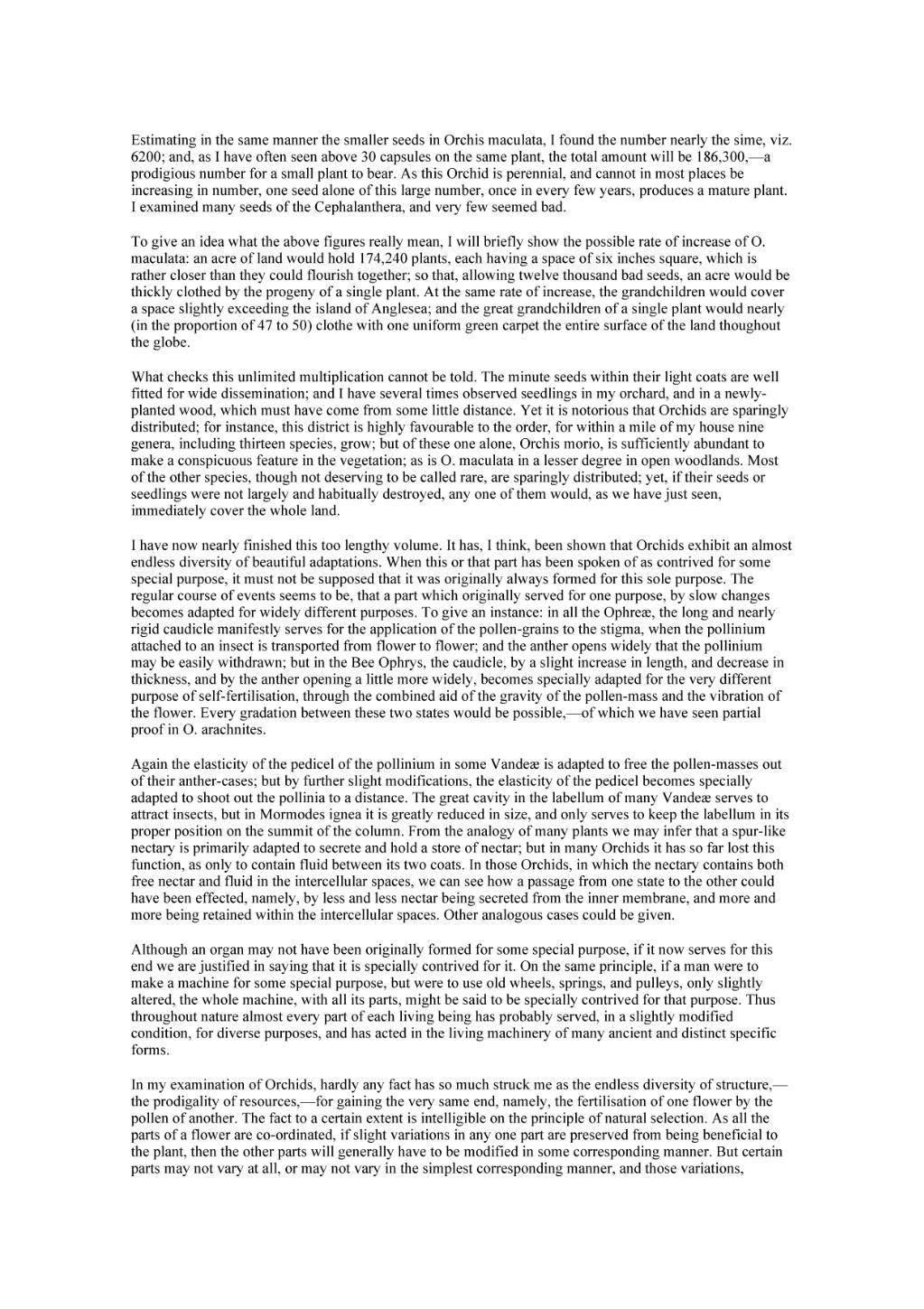Estimating in the same manner the smaller seeds in Orchis maculata, I found the number nearly the sime, viz. 6200; and, as I have often seen above 30 capsules on the same plant, the total amount will be 186,300,—a prodigious number for a small plant to bear. As this Orchid is perennial, and cannot in most places be increasing in number, one seed alone of this large number, once in every few years, produces a mature plant. I examined many seeds of the Cephalanthera, and very few seemed bad.
To give an idea what the above figures really mean, I will briefly show the possible rate of increase of O. maculata: an acre of land would hold 174,240 plants, each having a space of six inches square, which is rather closer than they could flourish together; so that, allowing twelve thousand bad seeds, an acre would be thickly clothed by the progeny of a single plant. At the same rate of increase, the grandchildren would cover a space slightly exceeding the island of Anglesea; and the great grandchildren of a single plant would nearly (in the proportion of 47 to 50) clothe with one uniform green carpet the entire surface of the land thoughout the globe.
What checks this unlimited multiplication cannot be told. The minute seeds within their light coats are well fitted for wide dissemination; and I have several times observed seedlings in my orchard, and in a newly-planted wood, which must have come from some little distance. Yet it is notorious that Orchids are sparingly distributed; for instance, this district is highly favourable to the order, for within a mile of my house nine genera, including thirteen species, grow; but of these one alone, Orchis morio, is sufficiently abundant to make a conspicuous feature in the vegetation; as is O. maculata in a lesser degree in open woodlands. Most of the other species, though not deserving to be called rare, are sparingly distributed; yet, if their seeds or seedlings were not largely and habitually destroyed, any one of them would, as we have just seen, immediately cover the whole land.
I have now nearly finished this too lengthy volume. It has, I think, been shown that Orchids exhibit an almost endless diversity of beautiful adaptations. When this or that part has been spoken of as contrived for some special purpose, it must not be supposed that it was originally always formed for this sole purpose. The regular course of events seems to be, that a part which originally served for one purpose, by slow changes becomes adapted for widely different purposes. To give an instance: in all the Ophreæ, the long and nearly rigid caudicle manifestly serves for the application of the pollen-grains to the stigma, when the pollinium attached to an insect is transported from flower to flower; and the anther opens widely that the pollinium may be easily withdrawn; but in the Bee Ophrys, the caudicle, by a slight increase in length, and decrease in thickness, and by the anther opening a little more widely, becomes specially adapted for the very different purpose of self-fertilisation, through the combined aid of the gravity of the pollen-mass and the vibration of the flower. Every gradation between these two states would be possible,—of which we have seen partial proof in O. arachnites.
Again the elasticity of the pedicel of the pollinium in some Vandeæ is adapted to free the pollen-masses out of their anther-cases; but by further slight modifications, the elasticity of the pedicel becomes specially adapted to shoot out the pollinia to a distance. The great cavity in the labellum of many Vandæe serves to attract insects, but in Mormodes ignea it is greatly reduced in size, and only serves to keep the labellum in its proper position on the summit of the column. From the analogy of many plants we may infer that a spur-like nectary is primarily adapted to secrete and hold a store of nectar; but in many Orchids it has so far lost this function, as only to contain fluid between its two coats. In those Orchids, in which the nectary contains both free nectar and fluid in the intercellular spaces, we can see how a passage from one state to the other could have been effected, namely, by less and less nectar being secreted from the inner membrane, and more and more being retained within the intercellular spaces. Other analogous cases could be given.
Although an organ may not have been originally formed for some special purpose, if it now serves for this end we are justified in saying that it is specially contrived for it. On the same principle, if a man were to make a machine for some special purpose, but were to use old wheels, springs, and pulleys, only slightly altered, the whole machine, with all its parts, might be said to be specially contrived for that purpose. Thus throughout nature almost every part of each living being has probably served, in a slightly modified condition, for diverse purposes, and has acted in the living machinery of many ancient and distinct specific forms.
In my examination of Orchids, hardly any fact has so much struck me as the endless diversity of structure,—the prodigality of resources,—for gaining the very same end, namely, the fertilisation of one flower by the pollen of another. The fact to a certain extent is intelligible on the principle of natural selection. As all the parts of a flower are co-ordinated, if slight variations in any one part are preserved from being beneficial to the plant, then the other parts will generally have to be modified in some corresponding manner. But certain parts may not vary at all, or may not vary in the simplest corresponding manner, and those variations,
